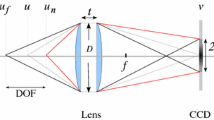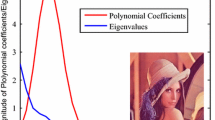Abstract
According to the thin lens model, the classic depth of field (DOF) is defined as the distance range at which objects in front of a camera are in focus. However, the thin lens poses important practical limitations for modeling the camera focus due to its dependence on internal parameters, such as the focal length, numerical aperture and effective pixel size. In this paper, a new model for describing the focus of conventional digital cameras is proposed. The focus is modeled as the energy of the point-spread-function of the imaging system and describes the joint effect of defocus, diffraction and digitization. Experiments conducted on different acquisition devices show that the proposed model conforms accurately to the behavior of real systems and outperforms the most similar alternatives in the state-of-the-art. In addition, in contrast to the classic DOF model, the proposed approach can be used to predict the changes in the focus of conventional digital cameras when changing focus, zoom, and aperture by means of a simple calibration process.











Similar content being viewed by others
Notes
In this paper, the lens focal length describes the power of the optics and should not be confused with the same term often used in the perspective projection model of cameras.
In the sequel, uppercase letters will be used to denote the Fourier transform of the corresponding functions.
References
Abramowitz, M., & Davidson, M. W. (2012). Numerical aperture and resolution. Accessed October 22, 2012.
Aguet, F., Van De Ville, D., & Unser, M. (2008). Model-based 2.5-D deconvolution for extended depth of field in brightfield microscopy. IEEE Transactions on Image Processing, 17(7), 1144–1153.
Allen, E., & Triantaphillidou, S. (2011). The manual of photography (10th ed.). Waltham: Focal Press.
Bass, M., Decusatis, C., Enoch, J. M., Lakshminarayanan, V., Li, G., McDonald, C., Mahajan, V. N. & van Stryland, E. (2009). Geometrical and physical optics, polarized light, components and instruments. In Handbook of optics (Vol. 1, 3rd ed.). OSA.
Born, M., & Wolf, E. (1999). Principles of optics (7th ed.). Cambridge: Cambridge University Press.
Cao, G., Zhao, Y., & Ni, R. (2010). Edge-based blur metric for tamper detection. Journal of Information Hiding and Multimedia Signal Processing, 1(1), 20–27.
Chen, S., & Li, Y. F. (2013). Finding optima focusing distance and edge blur distribution for weakly calibrated 3d vision. IEEE Transactions on Industrial Informatics, 9(3), 1680–1687.
Chern, N. N. K., Neow, P. A., & Ang, M. H. (2001). Practical issues in pixel-based autofocusing for machine vision. In Proceedings of IEEE international conference on robotics and automation (Vol. 3, pp. 2791–2796).
Cody, W. J. (1969). Rational chebyshev approximations for the error function. Mathematics of Computation, 23(107), 631–637.
de Angelis, M., Nicola, S. D., Ferraro, P., Finizio, A., Pierattini, G., & Hessler, T. (1999). An interferometric method for measuring short focal length refractive lenses and diffractive lenses. Optics Communications, 160(1–3), 5–9.
Ersoy, O. K. (2007). Diffraction, Fourier optics and imaging. New York: Wiley.
Favaro, P. (2007). Shape from focus and defocus: Convexity, quasiconvexity and defocus-invariant textures. In Proceedings of international conference on computer vision (pp. 1–7).
Favaro, P., & Soatto, S. (2005). A geometric approach to shape from defocus. IEEE Transactions on Pattern Analysis and Machine Intelligence, 27(3), 406–417.
FitzGerrell, A. R., Edward, R., Dowski, J., & Cathey, W. T. (1997). Defocus transfer function for circularly symmetric pupils. Applied Optics, 36(23), 5796–5804.
Goodman, J. W. (1996). Introduction to Fourier optics (2nd ed.). New York: McGraw-Hill.
Hart, J. F. (1968). Computer approximations. New York: Willey.
Hasinoff, S., & Kutulakos, K. (2011). Light-efficient photography. IEEE Transactions on Pattern Analysis and Machine Intelligence, 33(11), 2203–2214.
He, J., Zhou, R., & Hong, Z. (2003). Modified fast climbing search auto-focus algorithm with adaptive step size searching technique for digital camera. IEEE Transactions on Consumer Electronics, 49(2), 257–262.
Healey, G., & Kondepudy, R. (1994). Radiometric CCD camera calibration and noise estimation. IEEE Transactions on Pattern Analysis and Machine Intelligence, 16(3), 267–276.
Heikkila, J., & Silven, O. (1997). A four-step camera calibration procedure with implicit image correction. In Proceedings of conference on computer vision and pattern recognition (pp. 1106–1112).
Hopkins, H. H. (1955). The frequency response of a defocused optical system. Proc. R. Soc. Lond., 231, 91–103.
Horn, B. K. P. (1990). Robot vision (6th ed.). Cambridge: MIT Press.
Ito, A., Tambe, S., Mitra, K., Sankaranarayanan, A. C., & Veeraraghavan, A. (2014). Compressive epsilon photography for post-capture control in digital imaging. ACM Transactions on Graphics, 33(4), 88:1–88:12.
Jeon, J., Lee, J., & Paik, J. (2011). Robust focus measure for unsupervised auto-focusing based on optimum discrete cosine transform coefficients. IEEE Transactions on Consumer Electronics, 57(1), 1–5.
Jeon, J., Yoon, I., Kim, D., Lee, J., & Paik, J. (2010). Fully digital auto-focusing system with automatic focusing region selection and point spread function estimation. IEEE Transactions on Consumer Electronics, 56(3), 1204–1210.
Joshi, N., Szeliski, R., & Kriegman, D. (2008). PSF estimation using sharp edge prediction. In Proceedings of computer vision and pattern recognition.
Kehtarnavaz, N., & Oh, H. J. (2003). Development and real-time implementation of a rule-based auto-focus algorithm. Real-Time Imaging, 9, 197–203.
Lai, Y. C. (2011). PSO-based estimation for gaussian blur in blind image deconvolution problem. In Proceedings of IEEE international conference on fuzzy systems (pp. 1143–1148).
Lei, F., & Dang, L. K. (1994). Measuring the focal length of optical systems by grating shearing interferometry. Applied Optics, 33(28), 6603–6608.
Liu, C., Szeliski, R., Kang, S. B., Zitnick, C., & Freeman, W. (2008). Automatic estimation and removal of noise from a single image. IEEE Transactions on Pattern Analysis and Machine Intelligence, 30(2), 299–314.
Mahmood, M., & Choi, T.-S. (2010). Focus measure based on the energy of high-frequency components in the s transform. Optics Letters, 35(8), 1272–1274.
Minhas, R., Mohammed, A. A., & Wu, Q. J. (2011). Shape from focus using fast discrete curvelet transform. Pattern Recognition, 44(4), 839–853.
Muhammad, M., & Choi, T.-S. (2012). Sampling for shape from focus in optical microscopy. IEEE Transactions on Pattern Analysis and Machine Intelligence, 34(3), 564–573.
Muhammad, M., Mutahira, H., Majid, A., & Choi, T.-S. (2009). Recovering 3d shape of weak textured surfaces. In Proceedings of international conference on computational science and its applications (pp. 191–197).
Nayar, S. K., & Nakagawa, Y. (1994). Shape from focus. IEEE Transactions on Pattern Analysis and Machine Intelligence, 16(8), 824–831.
Oppenheim, R. W., Schafer, R. W., & Buck, J. R. (1999). Discrete-time digital signal processing. Englewood Cliffs: Prentice Hall.
Orieux, F., Giovanelli, J. F., & Rodet, T. (2010). Deconvolution with gaussian blur parameter and hyperparameters estimation. In Proceedings of IEEE international conference on acoustics, speech and signal processing (pp. 1350–1353).
Paramanand, C., & Rajagopalan, A. N. (2012). Depth from motion and optical blur with an unscented Kalman filter. IEEE Transactions on Image Processing, 21, 2798–2811.
Pertuz, S., Garcia, M. A., & Puig, D. (2015). Efficient focus sampling through depth-of-field calibration. International Journal of Computer Vision, 112(3), 342–353.
Pertuz, S., Puig, D., Garcia, M., & Fusiello, A. (2012a). Generation of all-in-focus images by noise-robust selective fusion of limited depth-of-field images. IEEE Transactions on Image Processing, 22(3), 1242–1251.
Pertuz, S., Puig, D., & Garcia, M. A. (2012b). Analysis of focus measure operators for shape-from-focus. Pattern Recognition, 45(5), 1415–1432.
Pollefeys, M., Koch, R., & Gool, L. V. (1999). Self-calibration and metric reconstruction inspite of varying and unknown intrinsic camera parameters. International Journal of Computational Vision, 32(1), 7–25.
Pratt, W. K. (2007). Digital image processing: PISK scientific inside (4th ed.). New York: Willey.
Qin, F. Q. (2010). Blind image surper-resolution reconstruction based on PSF estimation. In Proceedings of international conference on information and automation (pp. 1200–1203).
Rottenfusser, R., Wilson, E. E., & Davidson, M. W. (2012). Numerical aperture and resolution. Accessed February 11, 2016.
Stokseth, P. A. (1969). Properties of a defocused optica-system. Journal of the Optical Society of America, 59, 1314–1321.
Subbarao, M., & Tian, J.-K. (1998). Selecting the optimal focus measure for autofocusing and depth-from-focus. IEEE Transactions on Pattern Analysis and Machine Intelligence, 20(8), 864–870.
Sundaram, H., & Nayar, S. (1997). Are textureless scenes recoverable? In Proceedings of IEEE conference on computer vision and pattern recognition (pp. 814–820).
Tay, C., Thakur, M., Chen, L., & Shakher, C. (2005). Measurement of focal length of lens using phase shifting Lau phase interferometry. Optics Communications, 248(4–6), 339–345.
Taylor, J. R. (1997). An introduction to error analysis. The study of uncertainties in physical measurements (2nd ed.). Sausalito: University Science Books.
Tenenbaum, J. M. (1971). Accommodation in computer vision. Ph.D. thesis, Stanford University.
Tsai, D.-C., & Chen, H. (2016). Focus profile modeling. IEEE Transactions on Image Processing, 25(2), 818–828.
Tsai, D. C., & Chen, H. H. (2012). Reciprocal focus profile. IEEE Transactions on Image Processing, 21(2), 459–468.
Voeltz, D. G. (2010). Computational Fourier optics. Bellingham: SPIE Press.
Yousefi, S., Rahman, M., & Kehtarnavaz, N. (2011). A new auto-focus sharpness function for digital and smart-phone cameras. IEEE Transactions on Consumer Electronics, 57(3), 1003–1009.
Author information
Authors and Affiliations
Corresponding author
Additional information
Communicated by Yasuyuki Matsushita.
Electronic supplementary material
Below is the link to the electronic supplementary material.
Rights and permissions
About this article
Cite this article
Pertuz, S., Garcia, M.A., Puig, D. et al. A Closed-Form Focus Profile Model for Conventional Digital Cameras. Int J Comput Vis 124, 273–286 (2017). https://doi.org/10.1007/s11263-017-1024-8
Received:
Accepted:
Published:
Issue Date:
DOI: https://doi.org/10.1007/s11263-017-1024-8




